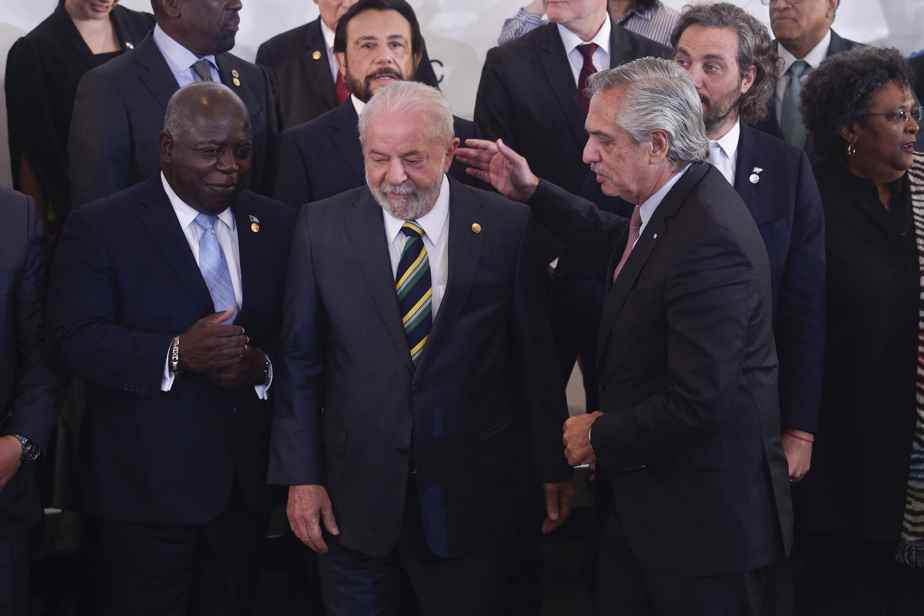(Buenos Aires) Fifteen heads of state and governments of Latin America, gathered at a summit in Buenos Aires around the Brazilian ghost Lula, were summoned on Tuesday to “strengthen” regional integration, to ward off threats to their institutions, such as the demonstrations that targeted places of power in Brasilia in early January.
“Brazil is back in the region”, launched its president Luiz Inacio Lula da Silva, at the VII summit of the Community of Latin American and Caribbean States (Celac, 33 member countries), that the South American giant formally reinstated, three years after Jair Bolsonaro, the far-right ex-president, released him.
“Brazil is ready to work side by side with all of you,” continued the 77-year-old left-wing leader, who three weeks into his 3e mandate (after two from 2003 to 2010), had chosen its neighbor and ally, Argentina, and Latin America for its first international outing.
Over the past 48 hours, Lula has pledged to relaunch integration in all directions “bilaterally, in Mercosur, in Unasur, in Celac”. Citing a customs union (Mercosur, with Argentina, Uruguay, and Paraguay) recently on the verge of tearing, and a moribund “South American Union” (Unasur) created in 2008 on his initiative and that of the Venezuelan Hugo Chavez.
Lula 2023 and Latin America, back to the future? Not really. Calls for regional integration have been accompanied by warnings in Buenos Aires, in light of threats to institutions, such as the Bolsonarist assault on seats of power in Brasilia on January 8.
The Brasília Syndrome
“We cannot allow a recalcitrant and fascistic ultra-right to jeopardize the institutions of our peoples”, launched the host president, the Argentinian Alberto Fernandez (center left),
“Democracy is clearly at risk”, with “sectors of the ultra-right which have recovered”, he added, citing in particular the “madness of Brasilia” or the attack against the Argentine vice-president Cristina Kirchner in September.
“We must strengthen the institutions of our region […] converting our words into institutions and deeds, making (regional) integration a reality,” Fernandez continued.
Created in 2010 at the initiative of Lula in particular, Celac is a forum for dialogue and cooperation, not a regional integration body with binding deliberations. Over time, his voice has struggled to be united or to weigh, still to this day in crises on the continent, as currently in Peru.
“Latin America is institutionally bankrupt […] It has not succeeded in integrating collectively into the world”, diagnosis for AFP Ignacio Bartesaghi, expert in International Relations and regional integration of the Catholic University of Uruguay.
At the very least, Celac “remains a vast and heterogeneous space of Latin American countries from which minimal agendas or common interest for the region can be established”, admits Bernabé Malacalza, analyst in International Relations at the Center Argentinian National Research Center Conicet.
“Ideological Club”, until when?
And Celac remains the reference regional interlocutor of China, or of the EU, on cooperation agendas. But the last EU-Celac summit dates back to 2018… even if the two parties committed at the end of 2022, at ministerial level, to aiming for a bi-regional summit in 2023, where Spain will have the EU presidency on 2e semester.
Uruguayan President Luis Lacalle Pou also urged his Latin American counterparts to “take action” towards integration, proposing a free trade zone that would go “from Mexico to the south of South America “.
Lacalle Pou, one of the rare centre-right presidents with a noticeably left-leaning summit, warned of Celac-type forums that “if they want to continue, they cannot keep this character of a club of ideological friends”.
And he called for not having “a hemiplegic vision” on human rights or institutional abuses, clearly referring to the regimes of Venezuela, Nicaragua and Cuba. Of the three, only Cuban President Miguel Diaz-Canel was present, and will have heard, for the umpteenth time, the region calling for the end of the American embargo on the island.
After this reconstructed Latin American family photo, Lula, whose diplomacy intends everywhere to “rebuild bridges” post-Bolsonaro, will turn to other strategic meetings: Washington on February 10, and China “after March”.
